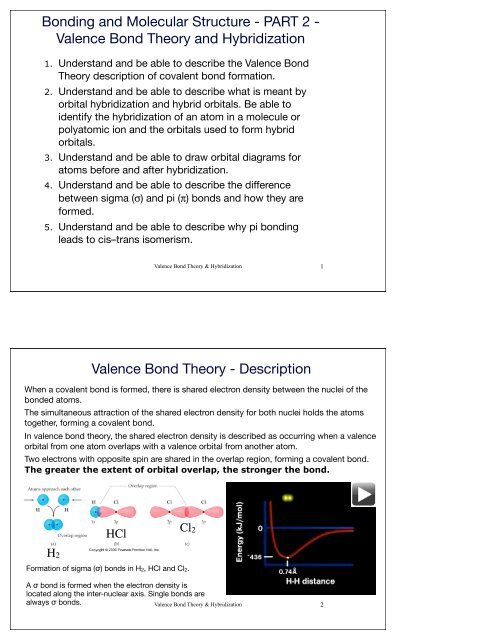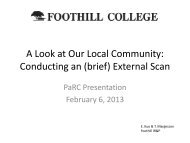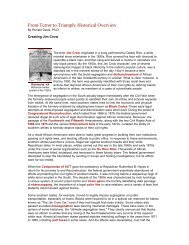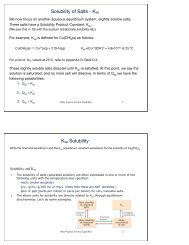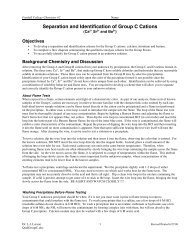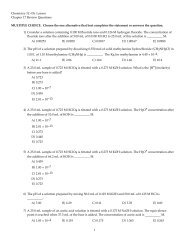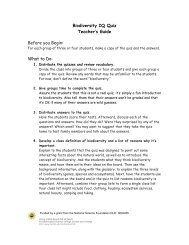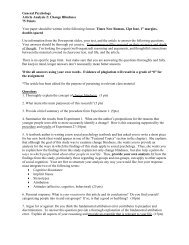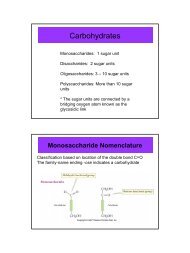Chapter 9 - Hybridization
Chapter 9 - Hybridization
Chapter 9 - Hybridization
You also want an ePaper? Increase the reach of your titles
YUMPU automatically turns print PDFs into web optimized ePapers that Google loves.
Bonding and Molecular Structure - PART 2 -<br />
Valence Bond Theory and <strong>Hybridization</strong><br />
1. Understand and be able to describe the Valence Bond<br />
Theory description of covalent bond formation.<br />
2. Understand and be able to describe what is meant by<br />
orbital hybridization and hybrid orbitals. Be able to<br />
identify the hybridization of an atom in a molecule or<br />
polyatomic ion and the orbitals used to form hybrid<br />
orbitals.<br />
3. Understand and be able to draw orbital diagrams for<br />
atoms before and after hybridization.<br />
4. Understand and be able to describe the difference<br />
between sigma (σ) and pi (π) bonds and how they are<br />
formed.<br />
5. Understand and be able to describe why pi bonding<br />
leads to cis–trans isomerism.<br />
Valence Bond Theory & <strong>Hybridization</strong> 1<br />
Valence Bond Theory - Description<br />
When a covalent bond is formed, there is shared electron density between the nuclei of the<br />
bonded atoms.<br />
The simultaneous attraction of the shared electron density for both nuclei holds the atoms<br />
together, forming a covalent bond.<br />
In valence bond theory, the shared electron density is described as occurring when a valence<br />
orbital from one atom overlaps with a valence orbital from another atom.<br />
Two electrons with opposite spin are shared in the overlap region, forming a covalent bond.<br />
The greater the extent of orbital overlap, the stronger the bond.<br />
H2<br />
HCl<br />
Cl2<br />
Formation of sigma (σ) bonds in H2, HCl and Cl2.<br />
A σ bond is formed when the electron density is<br />
located along the inter-nuclear axis. Single bonds are<br />
always σ bonds.<br />
Valence Bond Theory & <strong>Hybridization</strong> 2
Valence Bond Theory Description of Bond Formation in H 2<br />
• The electron configuration of hydrogen is 1s 1 . Each hydrogen atom has an<br />
unpaired electron in its valence 1s orbital.<br />
• As the two hydrogen atoms approach each other, their 1s orbitals begin to<br />
merge (overlap). Electron density builds up in this overlap region where two<br />
valence electrons with opposite spin are shared, forming a sigma bond.<br />
• As the two H atoms come closer and closer together, the overlap between<br />
the 1s orbitals increases and the potential energy of the system decreases to<br />
a minimum and then starts to increase as the electrostatic repulsion between<br />
the two nuclei starts to become significant at short internuclear distances.<br />
• The internuclear distance at the minimum potential energy corresponds to<br />
the observed bond length.<br />
• The energy released (exothermic process) as the bond is formed<br />
corresponds to the bond energy (or bond enthalpy). An input of this amount<br />
of energy is required to break the bond (endothermic process) that has<br />
formed.<br />
Valence Bond Theory & <strong>Hybridization</strong> 3<br />
Question: The formation of other simple diatomic molecules with single<br />
bonds, such as HF and Br2 can be described in a similar way as the<br />
formation of H2.<br />
In the case of HF, which atomic orbitals are used to form the bond?<br />
In the case of Br2, which atomic orbitals are used to form the bond?<br />
Valence Bond Theory & <strong>Hybridization</strong> 4
How do we Explain the Bonding in Covalent Molecules To Give the<br />
Correct Shapes Predicted by VSEPR Theory?<br />
How can we use valence bond theory to adequately describe the bonding for polyatomic molecules or<br />
ions having electron-domain geometries such as linear, trigonal planar, tetrahedral, trigonal bipyramid or<br />
octahedral? Overlap of atomic s, p and d orbitals will not yield structures with these geometries (except<br />
linear)! To explain bonding for these geometries, valence bond theory uses the concept of orbital<br />
hybridization.<br />
Orbital <strong>Hybridization</strong> (proposed by Linus Pauling): To understand this concept, we need to<br />
remember that the atomic s, p, d and f orbitals are described by mathematical functions. These<br />
functions are actually probability distributions, giving the probability of finding an electron with a specific<br />
energy in an atom.<br />
Orbital hybridization is simply the mathematical combination of two or more<br />
atomic orbitals (s, p, or d) to form new hybrid orbitals that are used for bonding.<br />
Valence Bond Theory (<strong>Hybridization</strong>)<br />
Central atoms do not use atomic (s, p, d, f) orbitals to form sigma bonds.<br />
Central atoms mix or hybridize their valence atomic orbitals to form new bonding orbitals<br />
called hybrid orbitals.<br />
sp 2<br />
Valence Bond Theory & <strong>Hybridization</strong> 5<br />
<strong>Hybridization</strong> - sp, and sp 2 and sp 3 OVERVIEW<br />
sp<br />
sp 3<br />
Valence Bond Theory & <strong>Hybridization</strong> 6
Hybrid Orbital Formation: Orbital <strong>Hybridization</strong> Basics<br />
1. When forming hybrid orbitals, the number of hybrid orbitals formed equals the<br />
number of orbitals mathematically combined or “mixed”. For example, if an s orbital<br />
is combined with a p orbital the result is two “sp” hybrid orbitals.<br />
2. Hybrid orbitals have orientations around the central atom that correspond to the<br />
electron-domain geometry predicted by the VSEPR Theory.<br />
3. The hybrid orbitals have shapes that maximize orbital overlap with another atoms<br />
orbitals. This increases bond strength.<br />
4. Hybrid orbital overlap between atoms creates SIGMA bonds.<br />
The logical sequence to determine hybridization is:<br />
Valence Bond Theory & <strong>Hybridization</strong> 7<br />
Correlation Between VSEPR Theory and <strong>Hybridization</strong><br />
Formula —> Lewis Structure —> VSEPR Electron Domain Geometry —> <strong>Hybridization</strong><br />
There is a direct correlation between VSEPR electron domain geometry and the hybridization<br />
of the central atom.<br />
VSEPR Electron Domain<br />
Geometry<br />
<strong>Hybridization</strong> Example<br />
Linear sp BeF2<br />
Trigonal Planer sp 2 NO3 –<br />
Tetrahedral sp 3 CH 4<br />
Trigonal Bipyramidal sp 3 d PCl 5<br />
Octahedral sp 3 d 2 SF 6<br />
Valence Bond Theory & <strong>Hybridization</strong> 8
Energy<br />
Correlation Between VSEPR Theory and <strong>Hybridization</strong><br />
Valence Bond Theory & <strong>Hybridization</strong> 9<br />
Energies of <strong>Hybridization</strong> - sp 3 <strong>Hybridization</strong> for Carbon<br />
(Tetrahedral Electron Domain Geometry)<br />
Atomic Orbitals for CARBON Hybrid Orbitals for CARBON<br />
2s<br />
2p<br />
sp 3 hybridize<br />
Mix the 2s and 3 2p<br />
orbitals, hence sp 3<br />
hybridization.<br />
Four equivalent sp 3 hybrid<br />
orbitals for bonding.<br />
Valence Bond Theory & <strong>Hybridization</strong> 10
Carbon <strong>Hybridization</strong> in Ethane - sp 3<br />
Sigma bond (σ): the first bond formed between two atoms.<br />
All single bonds are sigma bonds.<br />
Valence Bond Theory & <strong>Hybridization</strong> 11<br />
Valence Bond Theory Description of Bonding in H2O<br />
1. What is the hybridization of the oxygen atom in water?<br />
2. Draw the orbital energy diagram for the valence shell of the oxygen atom before and after<br />
hybridization. Show the electrons before and after hybridization. For the hybridized<br />
orbitals, indicate below each orbital whether the orbital holds a lone pair or is used to form<br />
a sigma bond.<br />
3. Make a sketch of orbitals showing the valence bond theory description of the bonding in<br />
H2O. Label on the sketch the orbitals used by each atom to form each bond.<br />
Valence Bond Theory & <strong>Hybridization</strong> 12
<strong>Hybridization</strong> in Methanol - O sp 3 and C sp 3<br />
Valence Bond Theory & <strong>Hybridization</strong> 13<br />
Expanded Octets: Bonding in SF4<br />
1.What is the hybridization of the sulfur atom in SF 4?<br />
2.Draw the orbital energy diagram for the valence shell of the sulfur atom before and after<br />
hybridization. Show the electrons before and after hybridization. For the hybridized<br />
orbitals, indicate below each orbital whether the orbital holds a lone pair or is used to form<br />
a sigma bond.<br />
Valence Bond Theory & <strong>Hybridization</strong> 14
What about MULTIPLE BONDS?<br />
Valence Bond Theory description of Multiple Bond Formation.<br />
1. Multiple covalent bonds (double and triple) form when more then one orbital from each<br />
atom overlap.<br />
2. This additional overlap occurs using UNHYBRIDIZED atomic orbitals, not hybrid<br />
orbitals. This overlap is called a pi (π) bond formation.<br />
Energy<br />
Sigma bond (σ): the first bond formed<br />
between two atoms.<br />
All single bonds are sigma bonds.<br />
Pi (π) bond: the second or third bond<br />
formed between two atoms.<br />
Single bond = sigma bond (σ)<br />
Double bond = sigma + pi (σ + π)<br />
Triple bond = sigma + pi + pi (σ + π + π)<br />
Valence Bond Theory & <strong>Hybridization</strong> 15<br />
A Double Bond - sp 2 <strong>Hybridization</strong> of Carbon<br />
(Trigonal Planar Electron Domain Geometry, H 2C=CH 2)<br />
2p<br />
Three equivalent sp 2<br />
hybrid orbitals.<br />
One p orbital is not<br />
mixed on each carbon.<br />
The three sp 2 hybrid<br />
orbitals form sigma bonds<br />
with H or the other<br />
carbon.<br />
The unhybridized p orbital<br />
from each carbon overlap<br />
to form the pi bond.<br />
Valence Bond Theory & <strong>Hybridization</strong> 16
Complete Bonding Description in H2CO<br />
The bonding in formaldehyde can be explained by sp 2<br />
hybridization.<br />
The H-C sigma bonds come from overlap of the 1s<br />
orbital of H with a sp 2 hybrid orbital on carbon.<br />
The C-O sigma bond comes from overlap of a sp 2<br />
hybrid orbital on C with another sp 2 hybrid<br />
orbital on oxygen.<br />
(O is sp 2 hybridized as well)<br />
The C-O pi bond comes from overlap of a<br />
2p atomic orbital on C with another 2p<br />
atomic orbital on oxygen.<br />
Valence Bond Theory & <strong>Hybridization</strong> 17<br />
Details: Pi Bonding Restricts Rotation Around the Inter-nuclear Axis<br />
at Room Temperature<br />
Valence Bond Theory & <strong>Hybridization</strong> 18
Restricted Rotation Give cis- and trans- Isomers<br />
Geometric Isomers: Geometric isomers are compounds that have the same molecular<br />
formula and order of attachment of the atoms, but different special arrangement of the atoms<br />
relative to each other. Restricted rotation around a pi bond results in a type of geometric<br />
isomerism known as cis-trans isomerism.<br />
These are two DIFFERENT MOLECULES that do not interconvert. They exist separately and have<br />
different physical properties.<br />
cis isomer: like atoms are located on the<br />
same side of the double bond.<br />
Density: 1.28 g/mL Melting pt. -80.5 °C<br />
Boiling pt: 60.3 °C Dipole: 1.9 D<br />
trans isomer: like atoms are located on<br />
opposite sides of the double bond.<br />
Density: 1.26 g/mL Melting pt: -49.5 °C<br />
Boiling pt: 47.5 °C Dipole: 0 D<br />
Valence Bond Theory & <strong>Hybridization</strong> 19<br />
cis- and trans- Isomers: Vision<br />
Cis<br />
cis isomer:<br />
rhodopsin in the normal or “relaxed” state.<br />
Trans<br />
trans isomer:<br />
rhodopsin after light absorption. Molecular<br />
geometry is changed to trans-form. This<br />
stimulates our nervous system to “see” the<br />
light.<br />
Valence Bond Theory & <strong>Hybridization</strong> 20
Acetylene, HCCH, a triple bonded molecule<br />
Acetylene has two pi bonds. There are formed<br />
from atomic p orbitals on each carbon.<br />
Valence Bond Theory & <strong>Hybridization</strong> 21<br />
<strong>Hybridization</strong> schemes - sp hybridization of carbon monoxide, CO<br />
Here we need to consider formal charge on each atom!<br />
Energy<br />
Hybrid Orbitals for Carbon Hybrid Orbitals for Oxygen<br />
Valence Bond Theory & <strong>Hybridization</strong> 22
Details: Delocalized pi Bonds - Resonance!<br />
Often when we have resonance the position of the pi bonds are not fixed but<br />
delocalized through the resonance structures. A classic example is benzene, C 6 H 6 .<br />
Resonance forms<br />
Resonance hybrid<br />
Which of the following molecules or ions can exhibit delocalized bonding:<br />
SO 2−<br />
3 , H2CO, O3 , NH +<br />
4 ?<br />
Valence Bond Theory & <strong>Hybridization</strong> 23<br />
Details: Pi Bonding with d Orbitals<br />
1. What is the hybridization of sulfur in SO 4 2- ?<br />
(Draw an expanded octet to minimize formal charges.)<br />
2. Draw the orbital ENERGY diagram of the sulfur atom after hybridization. Show the<br />
arrangement of valence electrons for sulfur after hybridization. For the orbitals, indicate<br />
below each orbital whether the orbital holds a lone pair or is used to form a sigma or pi<br />
bond with oxygen.<br />
Valence Bond Theory & <strong>Hybridization</strong> 24
Summary of what you should be able to do:<br />
1. Draw a correct Lewis Structure<br />
a) Expand Octets when necessary to reduce formal charges.<br />
b) Predict if there will be resonance:<br />
1. Draw all resonance forms.<br />
2. Use formal charges to predict the stability of any resonance form.<br />
3. Combine resonance forms into a resonance hybrid.<br />
4. Estimate the bond orders in the resonance hybrid.<br />
5. Predict relative bond lengths and bond strengths in the hybrid.<br />
c) For any Central Atom:<br />
1. Predict Electron Geometry - Name.<br />
2. Predict Molecular Geometry - Name.<br />
3. Predict any changes to ideal bond angles.<br />
d) Identify any polar bonds. Predict their direction and relative magnitude.<br />
e) Determine if the molecule as a whole will have a permanent dipole moment.<br />
f) Predict Orbital <strong>Hybridization</strong> of each Central Atom or Multiply Bonded Atom.<br />
1. Match the hybridization and bonding to the LEWIS STRUCTURE!<br />
2. Determine what orbitals overlap to form each sigma (σ) bond.<br />
3. Determine what orbitals overlap to form each pi (π) bond.<br />
4. Draw an energy level diagram for the hybrid orbitals.<br />
2. Draw the molecule in 3D.<br />
Valence Bond Theory & <strong>Hybridization</strong> 25<br />
Problems<br />
1. For each Lewis Structure<br />
(a) Give the electron domain geometry and the molecular geometry of each central atom.<br />
(b) Predict the ideal bond angles and if there are any deviations.<br />
(c) Identify each bond as polar or nonpolar.<br />
(d) Determine if the molecule has a permanent dipole moment.<br />
(e) Give the hybridization of each central atom and each atom with multiple bonds.<br />
(f) Describe the bonding as sigma and/or pi.<br />
(g) Describe what orbitals are used to make each sigma and/or pi bond.<br />
(h) In what orbitals are any lone pairs located?<br />
Valence Bond Theory & <strong>Hybridization</strong> 26
Problems<br />
Text Problem 9.5: The plot below shows the potential energy of two Cl atoms as a function<br />
of the distance between them.<br />
1. To what does an energy of zero correspond in this diagram?<br />
2. According to the valence-bond model, why does the energy decrease as the Cl<br />
atoms move from a large separation to a smaller one?<br />
3. What is the significance of the Cl-Cl distance at the minimum point in the plot?<br />
4. Why does the energy rise at Cl-Cl distances less than that at the minimum point in<br />
the plot?<br />
5. Label the part of the plot that corresponds to the bond energy of Cl2.<br />
Valence Bond Theory & <strong>Hybridization</strong> 27<br />
Problems from Textbook<br />
Text Problem 9.6:<br />
Shown below are three pairs of hybrid orbitals, with each set at a<br />
characteristic angle. For each pair, determine the type or types of<br />
hybridization that could lead to hybrid orbitals at the specified angle.<br />
Valence Bond Theory & <strong>Hybridization</strong> 28
Problems from Textbook<br />
Text Problem 9.49:<br />
(a) Draw a picture showing how two p orbitals can combined to make a<br />
sigma bond.<br />
(b) Sketch a π bond that is constructed from p orbitals.<br />
(c) Which is generally the stronger, a σ bond or a π bond? Explain.<br />
(d) Can two s orbitals make a π bond. Explain.<br />
Valence Bond Theory & <strong>Hybridization</strong> 29


